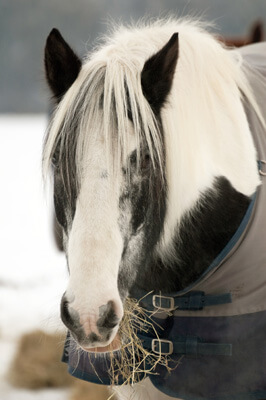Winter Horse Feed Management

While many elements can contribute to digestive upsets, feed management or lack thereof is a major factor. Proper feeding is something every owner can learn and make a part of their everyday routine.
Understanding the basics of the horse’s digestive system is paramount in understanding how feed management impacts gastrointestinal health. Since this article deals with the basics, it may be helpful to discuss the digestive tract and how each part functions. The mouth is not only the entrance to the digestive system, it has two very important functions: to chew and to produce saliva. Chewing initiates the breakdown of feedstuffs, so attention to proper dental care is essential. Saliva lubricates the feed to aid in swallowing and also contains buffers, which are important in buffering stomach acid. The esophagus connects the mouth to the stomach. Because the horse evolved as a free-roaming animal that grazed continuously, the stomach is very small relative to the horse’s body size. With domestication and today’s needs, many horses are maintained in small paddocks or stalls and are fed 2-3 times per day on a diet that often contains a high proportion of grains. Feeding the horse smaller, more frequent meals (4 or more) is one way to mimic grazing and may reduce digestive upset. Providing forage encourages more chewing, stimulating more salivary production, more buffering of stomach acid and better digesta flow through the digestive system. Digesta flows out of the stomach and into the small intestine, a long tube-like structure where most of the enzymatic digestion takes place and much of the absorption of nutrients occurs. Next in line are the large intestine and cecum, which comprise the last part of the digestive tract. Here, bacteria and protozoa digest fiber from plants and furnish much of the energy the horse consumes. This is also the site of water reabsorption.
Stage of production (e.g. lactating), amount of work and individualism all factor into a horse’s individual water requirement. A mature horse, weighing about 1,000-1,100 lbs., needs about 10 gallons of water per day for maintenance. A question often heard is “does a horse need less water in winter than in summer”? If the horse is doing the same amount of work at the same stage of production, etc., they need a similar amount of water winter and summer. One often-overlooked factor is the impact feed type has on water requirement. Consumption of lush pasture containing approximately 70 percent water may meet much of the horse’s daily water requirement. Many horses, however, get their fiber and roughage from hay instead of pasture. Hay contains about 10 percent moisture, so a horse eating hay would drink much more water than a horse on pasture. As an illustration, take a 1,100 lb. horse consuming 2 percent of their body weight per day as feed intake, or 22 lb. If they are on pasture containing 70 percent moisture (30 percent dry matter), he will eat about 73 lb. of pasture (dry matter/percent dry matter = as fed basis; 22 lb./.3 dry matter = 73 lb. total feed). This will be 22 lb. of dry matter and 51 lb. of water. To determine how much water he’s consuming, divide the weight of the water by 8 lb./gal. and you get about 6.4 gal. This is a little over half of his needs. Changing to hay, we would feed the horse 24 lb. of hay (22 lb. of dry matter), but now the water contribution from the roughage source is only 0.3 gal. Feeding the horse poor-quality forage will also increase the need for more water to help with digesta passage. Another important management note: In the winter, the water source the horse depends on may be frozen. Even if it’s only frozen for a day or two, this lack of water will increase the chance of feed impaction. One important thing to remember is snow is not a replacement for water.
Chewing initiates the breakdown of feedstuffs, so attention to proper dental care is essential.
Another factor is the amount of sand the horse may be exposed to due to being fed on the ground in sandy areas or even sand in the hay. Sand is frequently found in feeders. While we often remember to use a psyllium product while the horses are pastured on sandy soils or in dirt lots, in winter this may be overlooked.
Some feed management tips that can help minimize digestive disturbances:
- Always ensure the horse has continual access to clean water. Be sure he’s drinking, use buckets, use flow meters if you’re using automatic water or, if on pasture, ensure unfrozen sources. Check heated waterers for any electrical malfunction.
- Change feeds gradually. Take 7-10 days to make feed changes.
- Have teeth checked annually. Watch for dropped feed or quids.
- Check feeders for any foreign objects (e.g. sticks or stones) on a daily basis.
- Use a quality psyllium product like Farnam SandClear if you suspect the horse has appreciable sand intake.
- Add a quality electrolyte or salt-based product such as Farnam Apple Elite Electrolyte to the feed to encourage water consumption.
- If you suspect an issue, contact your veterinarian.
Apple Elite, Farnam and SandClear are trademarks of Farnam Companies, Inc.
Life with Horses Newsletter
Sign up now to stay connected with free helpful horse care tips, product updates, and special offers.





